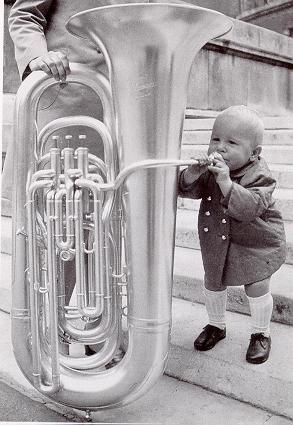

Tuba refers to a family of lip-vibrated, upright, valved, metal wind instruments witha folded tube of wide, conical bore. It was designed to fill an urgent need in brass bands for a satisfactory brass to the valved bugle. Although the Tuba was soon built in sizes ranging from an unsatisfactory B-flat soprano to various enormous double basses, only the baritone in B-flat (along with the wider bored euphonium) and the basses in F, E-flat, CC, and BB-flat survive.
In 1835, Berlin instrument maker Johann Gottfried Moritz, working with bandmaster Wilhelm Wieprecht, patented the first bass-tuba, completely distinct from the keyed ophicleide, the tuba's predecessor. in 1845, Adolfe Sax, working in Paris, patented a homogeneous family of Tubas under the name Sax-horn; these were subsequently adopted by French bands. Sax and other makers patented slightly different models under other names; the result was a confusing array of tuba instruments in all sizes. Among them is the Viennese helicon bass (1849), with it's circular coil formed to rest on the player's shoulder, provided an appropriate bass for the marching band and inspired the American sousaphone (1898). Also noteworthy are the 9-foot and 12-foot Wagner tubas in B-flat and F respectively; made with left hand valves and a relatively narrow bore and played by French Hornists, these instuments provided a new color midway between the mellow horn and the more agressive Tuba. Since the composition of Wagner's Ring, these instruments have been used in other large orchestral scores.